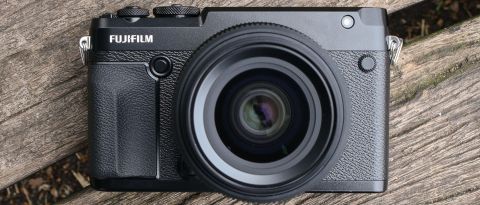Why you can trust TechRadar
Build and handling
- Magnesium alloy body
- Dust- and splash-resistant design
- Dual SDHC/SDXC card slots
For this kind of money we expect a high standard of construction and, at least on paper, there’s little that surprises. The body of the Fujifilm GFX 50R has been designed with magnesium alloy paneling for rigidity, while 64 weather seals protect the insides from any potential dust and moisture ingress, with the further bonus of freeze-proofing down to -10ºC. Reassuringly, this level of protection is the same as that afforded the lenses designed for the system so far.
Two card slots on the camera’s side allow you to load the body with a pair of SDHC, SDXC and older SD cards at any one time, and support is provided for both UHS-I and UHS-II cards. If there are any surprises, it’s that the camera's USB Type-C port is somewhat awkwardly placed behind a small door at its base, rather than at its side where we'd normally expect to find it. This is perhaps less of an issue when you have the camera mounted on a tripod (as it's still accessible), but it’s still less convenient.




While the body is leaner and less cluttered than the GFX 50S’s, there are still many direct controls that have come from the X-series bodies. Perhaps the most prominent are the shutter speed and exposure compensation dials found on the top plate, each milled from aluminum, and these are joined by a another dial around the shutter-release button to make three; with a further dial embedded into the back plate, those used to the twin-command-dial operation of high-end DSLRs should feel well catered for. The back plate also packs many controls we’re used to seeing, such as the useful AF joystick lever, and the Q button that enables you to jump straight to commonly used settings.
Considering the size of the body, the GFX 50R feels somewhat lighter in the hand than expected; indeed it’s light enough for one-handed operation, although this would only really be practical with a relatively small and light lens, such as the GF 63mm f/2.8 R WR and GF 45mm f/2.8 R WR lenses supplied for this review. That said, while it’s great to see just how compact Fujifilm has managed to make the body, a beefier grip would be appreciated. The grip clearly allows for better purchase than would otherwise be the case, but it feels too small when you consider the body and lenses it's supposed to support.
Autofocus
- Contrast-detect AF system
- 425 manually addressable points
- Manual focus with focus peaking
The GFX 50R’s autofocus system is a carbon copy of the system on its bigger brother. This works on a contrast-detect AF principle, rather than combining phase- and contrast-detect systems into a single hybrid system, as Fujifilm has done elsewhere in its camera range. Even so, much is familiar here, such as Single Point, Zone and Wide/Tracking options, as well as the option to change the size of focusing points to suit different subjects.
You can also specify the size of each Zone area when using the Zone mode, and you have the freedom to select one of 425 individual points across the frame when using the Single Point mode. Need to use continuous or manual focus? All you need to do is flick a switch on the back of the camera.
Given that this camera isn't targeted at action photographers, the lack of a hybrid AF system isn't unexpected. That said, autofocus on the whole isn’t quite as sprightly as on high-end DSLRs or mirrorless systems; this is clearly a camera that's more at home shooting static subjects than those in motion. The continuous focus system can't really drive the lens fast enough to keep up with moving subjects in the way that we would hope from a DSLR or mirrorless camera, but in good light the system is certainly fast enough to focus on static subjects without any frustration. Indeed, even in poor light the slowdown isn’t too severe, it’s just not quite on the level that we’ve become used to elsewhere.
Current page: Build, handling and AF
Prev Page Introduction and key features Next Page Performance and image quality